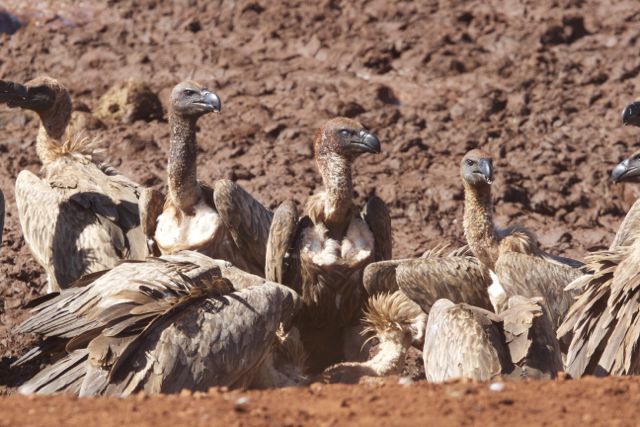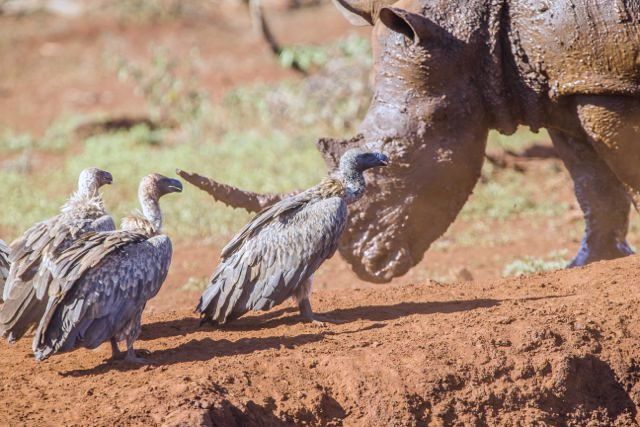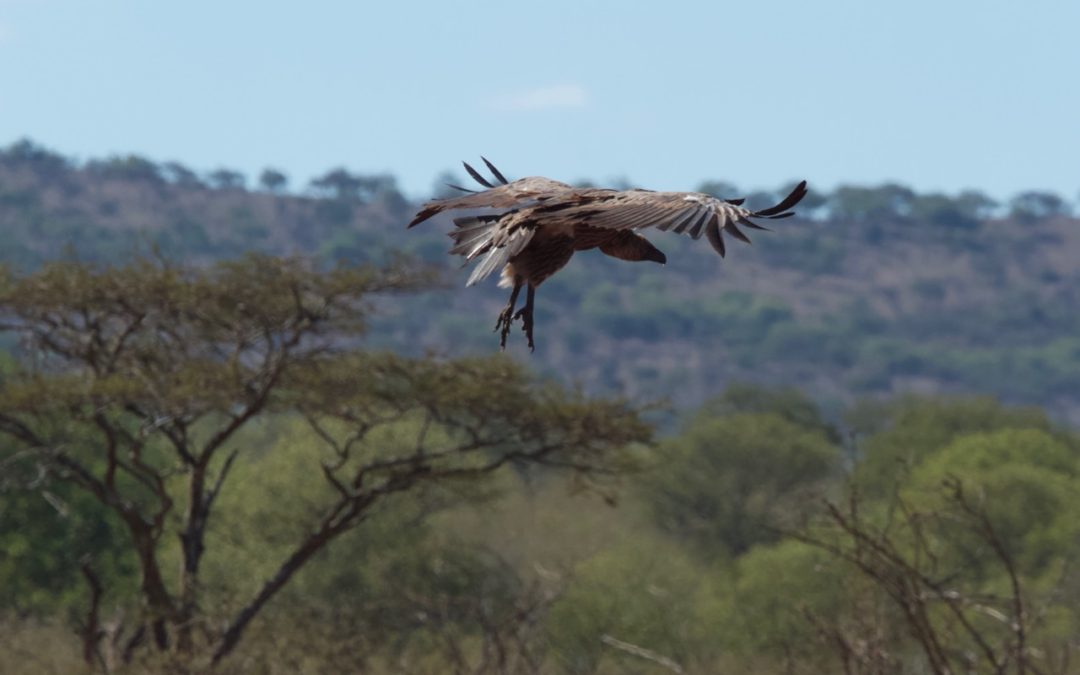 I am a cinematographer for National Geographic and Discovery Channel television, among others. In my down time I like to volunteer my services to worthwhile organizations around the globe. In this case my travels brought me to South Africa to help the kind folks at The Wildlife Act.
I am a cinematographer for National Geographic and Discovery Channel television, among others. In my down time I like to volunteer my services to worthwhile organizations around the globe. In this case my travels brought me to South Africa to help the kind folks at The Wildlife Act.
It was a windy afternoon and if you looked to the heavens you would notice that the sky was full of white backed vultures. As they coasted on the thermals high above the Zimanga game reserve, their numbers were too numerous to count. Being photographers, our first reaction was to grab the camera gear and head to the sight of the kill.
 The scene was simple. In the middle of a barren area there was a small depression that was filled with water, mud mostly, but a small amount of water. As we drove up it was impressive to discover there were more vultures on the ground than in the air.
The scene was simple. In the middle of a barren area there was a small depression that was filled with water, mud mostly, but a small amount of water. As we drove up it was impressive to discover there were more vultures on the ground than in the air.
Among the 75, or so, vultures busily swarming the remains of an Impala was a Lappet vulture. We could easily identify the enormous bird by the black and white body and red face. The Lappet was larger than the other white backed vultures and was positioned at the center of the decaying carcass. Generally, there is only two of these Lappet birds per kill. They are the first on the scene and maintain their supremacy by denying the other birds the ability to pick off the carcass.
 As we slowly closed on the kill site, the Lappet vulture flew off allowing the rest of the impatient vultures to rush in and feast. Near one of the edges of the hole was the hindquarter of the Impala. The birds thrust their heads into the carcass and rose up to reveal rotten hunks of flesh and intestines. Some birds would try to unceremoniously steal the morsels from the mouths of the other birds as they ate. The group stirred around flapping and pecking as they struggled for their turn at the carcass.
As we slowly closed on the kill site, the Lappet vulture flew off allowing the rest of the impatient vultures to rush in and feast. Near one of the edges of the hole was the hindquarter of the Impala. The birds thrust their heads into the carcass and rose up to reveal rotten hunks of flesh and intestines. Some birds would try to unceremoniously steal the morsels from the mouths of the other birds as they ate. The group stirred around flapping and pecking as they struggled for their turn at the carcass.
As we sat in the sweltering mid-afternoon sun we watched more vultures descend from the sky. Their immense wingspan reached a distance of up to 5 feet, tip to tip, and when they flew overhead you could hear the wind powerfully swirl from their wings as they controlled their majestic landing.
I wish I could tell you that these vultures were a beautiful bird, but, from my viewpoint, they may be the one the most unattractive birds I have ever seen. Their faces are blue in color, smooth, and noticeably expressionless. Their eyes are very dark and their overall demeanor oozes with the ora of death. **their look is just my opinion; others may find the bird to be quite beautiful.
 The experience did not stop there. As we watched, two white rhino’s approached the bog. One was a full grown female and the other an immature male (less than a year old). The birds started to scatter one by one as the rhinos entered the thick mud for an afternoon wallow. Much to the dismay of the remaining hungry birds, the rhinos took their time soaking in the quagmire.
The experience did not stop there. As we watched, two white rhino’s approached the bog. One was a full grown female and the other an immature male (less than a year old). The birds started to scatter one by one as the rhinos entered the thick mud for an afternoon wallow. Much to the dismay of the remaining hungry birds, the rhinos took their time soaking in the quagmire.
We were quite surprised to see what happened next. To our untrained eye, the birds seemed to become impatient with waiting for the rhinos and proceeded to take matters into their own hands. One by one they hopped towards the rhinos threatening and flapping their wings as if to chase the large beasts away…and it worked!
First, the little rhino got out of the mud hole and positioned himself nose to nose with a small group of vultures. The two stood in this manner for a period of a few minutes. It seemed as if neither side was going to budge, that is, until the enormous female rhino rose from the pit, painted with mud, and took her place in line with her baby.
 Amazingly this did not curb the effort of the birds. They just continued to hold their ground until the rhinos finally moved off. It was amazing! All of us commented on how unlikely it was that the vultures won this standoff. I guess it goes to show that no matter your size, in the animal kingdom, it’s persistence that can overcome any obstacle. In this particular case, even obstacle even as large as a 1.5 ton rhino and her baby.
Amazingly this did not curb the effort of the birds. They just continued to hold their ground until the rhinos finally moved off. It was amazing! All of us commented on how unlikely it was that the vultures won this standoff. I guess it goes to show that no matter your size, in the animal kingdom, it’s persistence that can overcome any obstacle. In this particular case, even obstacle even as large as a 1.5 ton rhino and her baby.
By: Byron Goggin, Photojournalist

